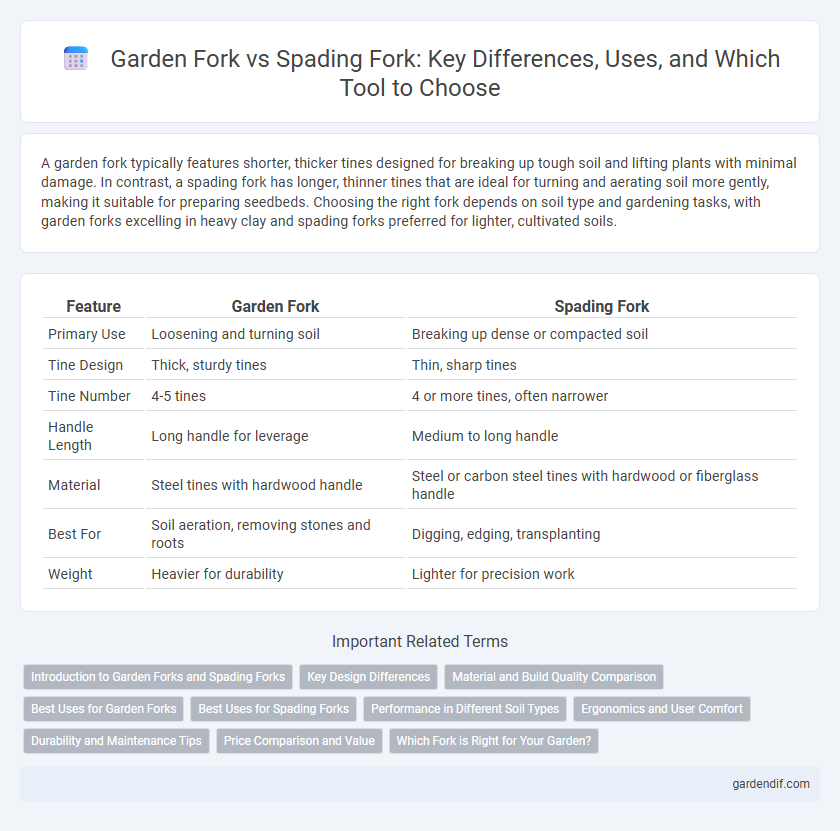
Garden fork vs spading fork Illustration
A garden fork typically features shorter, thicker tines designed for breaking up tough soil and lifting plants with minimal damage. In contrast, a spading fork has longer, thinner tines that are ideal for turning and aerating soil more gently, making it suitable for preparing seedbeds. Choosing the right fork depends on soil type and gardening tasks, with garden forks excelling in heavy clay and spading forks preferred for lighter, cultivated soils.
Table of Comparison
| Feature | Garden Fork | Spading Fork |
|---|---|---|
| Primary Use | Loosening and turning soil | Breaking up dense or compacted soil |
| Tine Design | Thick, sturdy tines | Thin, sharp tines |
| Tine Number | 4-5 tines | 4 or more tines, often narrower |
| Handle Length | Long handle for leverage | Medium to long handle |
| Material | Steel tines with hardwood handle | Steel or carbon steel tines with hardwood or fiberglass handle |
| Best For | Soil aeration, removing stones and roots | Digging, edging, transplanting |
| Weight | Heavier for durability | Lighter for precision work |
Introduction to Garden Forks and Spading Forks
Garden forks and spading forks are essential tools for soil cultivation and gardening tasks. A garden fork features sturdy, widely spaced tines designed for loosening compacted soil, aerating lawns, and lifting root crops. Spading forks, on the other hand, have narrower, sharper tines specialized for digging and breaking up dense soil with precision, making them ideal for preparing beds and working around plants.
Key Design Differences
A garden fork features broader, flatter tines designed for loosening compacted soil and aerating garden beds, while a spading fork has narrower, sharper tines ideal for digging and breaking up tougher, clay-heavy soil. The garden fork's thicker tines provide durability for turning soil without damaging plant roots, whereas the spading fork's slimmer profile allows for precision in cutting through dense earth. Ergonomic handles on both tools enhance leverage and reduce user fatigue, but the specific tine design remains the core difference influencing their distinct gardening applications.
Material and Build Quality Comparison
Garden forks typically feature heavy-duty forged steel tines designed for durability and resistance to bending, while spading forks often use lighter steel alloys with thinner tines to enhance soil penetration. The build quality of garden forks emphasizes robustness for handling tough soil and roots, incorporating thicker handles usually made of seasoned hardwood or reinforced fiberglass for longevity. Spading forks prioritize ergonomic design and lighter materials, such as aluminum handles, to reduce user fatigue during extended digging or aeration tasks.
Best Uses for Garden Forks
Garden forks excel at loosening and aerating soil in vegetable beds, breaking up compacted earth without excessive disturbance to root systems. Their sturdy, broad tines are ideal for turning compost and lifting root crops such as potatoes and carrots without damaging them. Unlike spading forks, garden forks are better suited for working in heavy clay soils and preparing large planting areas efficiently.
Best Uses for Spading Forks
Spading forks excel at breaking up heavy, compacted soil and aerating thick clay or garden beds, making them ideal for preparing ground before planting. Their straight, sharp tines penetrate deeply to turn soil without damaging delicate roots, perfect for transplanting and soil conditioning. Unlike garden forks, spading forks provide precise control when loosening soil around plants and removing deep-rooted weeds.
Performance in Different Soil Types
Garden forks excel in loose, sandy soils due to their wider tines that reduce compaction and increase aeration, enhancing root growth. Spading forks perform better in heavy clay or compacted soils, with their narrower, stronger tines designed to break up dense earth and remove weeds efficiently. Choosing the right fork based on soil type optimizes tilling performance and soil preparation.
Ergonomics and User Comfort
Garden forks typically feature shorter, straighter handles that promote better leverage and reduce wrist strain, making them suitable for digging and lifting heavy soil. Spading forks often have longer handles and slightly curved tines designed for turning and aerating soil, which enhances user comfort during prolonged use by minimizing bending. Ergonomically, choosing a fork with a cushioned grip and appropriate handle length tailored to the user's height significantly improves comfort and reduces fatigue in gardening tasks.
Durability and Maintenance Tips
Garden forks typically feature forged steel tines offering superior durability compared to spading forks, which often have thinner, stamped tines designed for lighter tasks. Maintaining garden forks involves regular cleaning to remove soil and debris, applying oil to prevent rust, and sharpening tines as needed for efficient penetration. Spading forks require gentle cleaning and occasional tine inspection to avoid bending or breaking, ensuring longevity through proper storage and minimal exposure to moisture.
Price Comparison and Value
Garden forks generally cost less than spading forks, making them a budget-friendly option for basic soil turning tasks. Spading forks, while more expensive, offer greater durability and versatility, providing long-term value for heavy-duty gardening and digging. Choosing between the two depends on balancing initial price with the frequency and intensity of use in your garden.
Which Fork is Right for Your Garden?
A garden fork features broader, flatter tines ideal for turning soil and breaking up compacted ground, making it perfect for general digging and aeration. In contrast, a spading fork has narrower, sharper tines designed to penetrate tough, root-filled soil and separate dense clumps, ideal for working with heavy or clay soils. Choosing the right fork depends on your soil type and gardening tasks, with garden forks suited for lighter, versatile work and spading forks best for heavy-duty soil cultivation.
Garden fork vs spading fork Infographic

 gardendif.com
gardendif.com